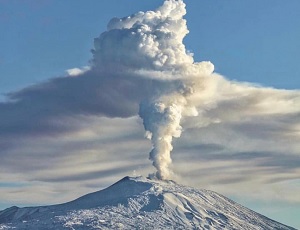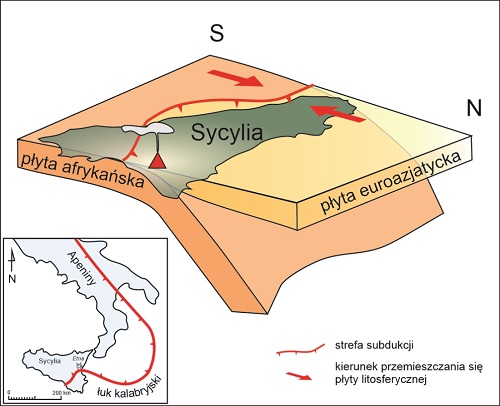
Over a week ago, information about streams of lava flowing from Mount Etna – the highest active volcano in Europe – made the news around the world. Is the volcanic activity in Sicily a matter of concern? The issue is addressed by Prof. Patrycja Wójcik-Tabol from the Institute of Geological Sciences of the Jagiellonian University.
The south-eastern mountainside of Etna ripped apart and the fiery cracks spit out lava and belched thick smoke. Gigantic volcanic bombs were thrown as far as several kilometres away. Streams of lava reached the city of Catania and flowed into the sea. The eruption took 122 days, lava flooded an area of 40 square kilometres and about 250 million cubic metres of tephra, that is, ash and pyroclastic rock were ejected into the air. This was the largest eruption of Etna in the known history, which occurred in 1669.
It is 2020. In the morning of April 19 an increased activity of Etna was reported. Small fountains of lava and plumes of ash were released near the new south-eastern crater. The outpouring of aa lava (resembling embers) was local and didn’t lead to the formation of lava flows. The pyroclastic cloud reached over a kilometre in height and moved south-east dropping small amounts of ashes in del Bove valley. The activity stopped in the early afternoon. There was no damage to property or injuries reported. “Red” alert was issued for air traffic, which was later reduced to “orange”. It did not affect the functioning of the airport in Catania, whose activity had already been limited due to the COVID-19 pandemic. This eruptive episode was classified as moderate. Indeed, it was only an episode!

A diagram of the subduction of the African Plate under the Eurasian Plate in Sicily region
(according to Doglioni et al., 2012, simplified). The bottom-left picture shows the subduction
zone along the Apennines and the Calabrian Arc (by Patrycja Wójcik-Tabol).
Etna is the second most active volcano on Earth, after Kilauea in the Hawaiian Islands. Its eruptive activity is twofold, comprising 1) explosive Strombolian-type eruptions, consisting in a long series of multiple bursts in the main crater zone and 2) incidental effusive eruptions, consisting in the outflow of large amounts of lava from cracks in the slopes of the volcano.
Etna massif is of elliptic shape with the perimeter of more than 135 kilometres. More than 3,300 metres high, it is the highest volcanic cone in Europe. It has four main craters, including the current peak of the mountain, which was created by the eruption in 1911, as well as over 250 minor craters.
The formation and the ongoing activity of Etna result from its location in the collision zone of two lithospheric plates, known as the subduction zone, where the African Plate meets with the Eurasian Plate, plunges beneath it and melts. The melted rocks emerge to the surface, creating volcanos. Mount Etna volcano originated about 500 thousand years ago. Its first eruptions occurred on the bottom of the sea.
The first volcanic activity of Etna recorded in the historic sources happened around 1,500 BC. The eruptions have varied in length, scale and destructiveness, but have seldom caused fatalities.
As a natural science lab and a unique tourist attraction, Etna is one of the most closely monitored and best known volcanoes in the world, which is facilitated by its relatively calm and predictable nature. It doesn’t pose as much danger as some other active volcanoes.
Original text by Prof. Patrycja Wójcik-Tabol from the Institute of Geological Sciences of the Jagiellonian University was published on the website: www.nauka.uj.edu.pl

Photos by Patrycja Wójcik-Tabol
Sources:
Tanguy, J. C., Condomines, M., Le Goff, M., Chillemi, V., La Delfa, S., & Patanè, G. (2007). Mount Etna eruptions of the last 2,750 years: revised chronology and location through archeomagnetic and 226 Ra-230 Th dating. Bulletin of Volcanology, 70(1), 55-83.
Doglioni, C. i in. (2012). The tectonic puzzle of the Messina area (Southern Italy): Insights from new seismic reflection data. Scientific reports, 2, 970. doi:10.1038/srep00970.
https://ingvvulcani.com/2019/03/07/la-grande-eruzione-delletna-del-1669-tra-vulcanologia-e-storia/





